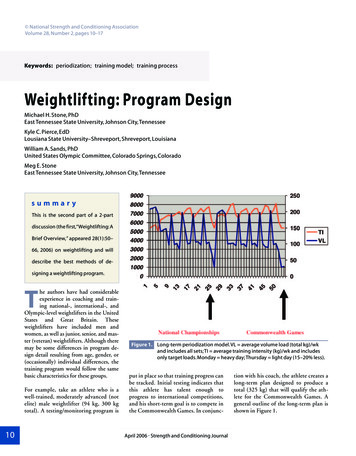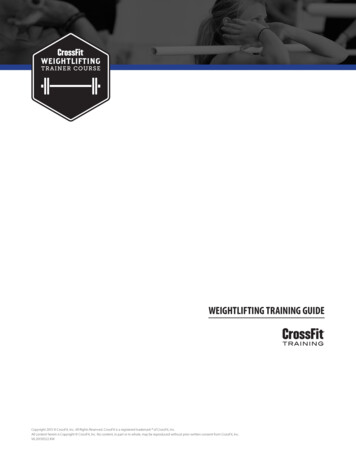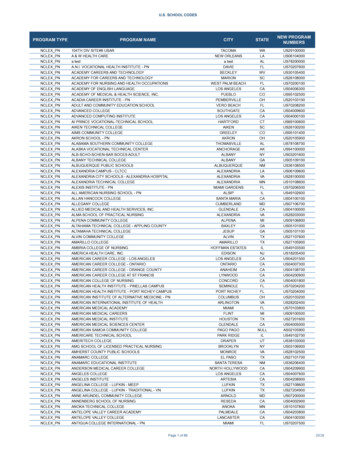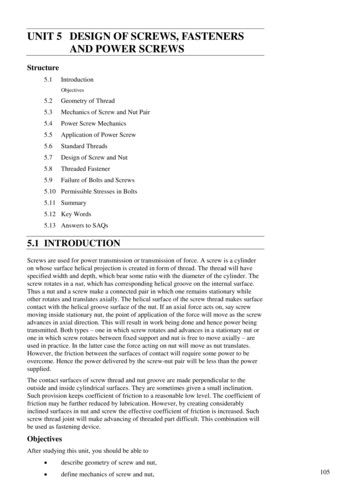
Transcription
National Strength and Conditioning AssociationVolume 28, Number 2, pages 10–17Keywords: periodization; training model; training processWeightlifting: Program DesignMichael H. Stone, PhDEast Tennessee State University, Johnson City,TennesseeKyle C. Pierce, EdDLousiana State University–Shreveport, Shreveport, LouisianaWilliam A. Sands, PhDUnited States Olympic Committee, Colorado Springs, ColoradoMeg E. StoneEast Tennessee State University, Johnson City,TennesseesummaryThis is the second part of a 2-partdiscussion (the first,“Weightlifting: ABrief Overview,” appeared 28(1):50–66, 2006) on weightlifting and willdescribe the best methods of designing a weightlifting program.he authors have had considerableexperience in coaching and training national-, international-, andOlympic-level weightlifters in the UnitedStates and Great Britain. Theseweightlifters have included men andwomen, as well as junior, senior, and master (veteran) weightlifters. Although theremay be some differences in program design detail resulting from age, gender, or(occasionally) individual differences, thetraining program would follow the samebasic characteristics for these groups.TFor example, take an athlete who is awell-trained, moderately advanced (notelite) male weightlifter (94 kg, 300 kgtotal). A testing/monitoring program is10Figure 1. Long-term periodization model.VL average volume load (total kg)/wkand includes all sets; TI average training intensity (kg)/wk and includesonly target loads. Monday heavy day; Thursday light day (15–20% less).put in place so that training progress canbe tracked. Initial testing indicates thatthis athlete has talent enough toprogress to international competitions,and his short-term goal is to compete inthe Commonwealth Games. In conjunc-April 2006 Strength and Conditioning Journaltion with his coach, the athlete creates along-term plan designed to produce atotal (325 kg) that will qualify the athlete for the Commonwealth Games. Ageneral outline of the long-term plan isshown in Figure 1.
Table 1a12-Week Preparation Phase Training Program for a Moderately TrainedWeightlifter (94 Kg, Total 300); First Mesocycle of the Training Year,General Concept of Sets and RepetitionsBlock 1Wk 1:Wk 2:Wk 3:Wk 4:3 103 103 103 10Block 2Wk 5:Wk 6:Wk 7:Wk 8:3 5 (1 5)3 5 (1 5)3 3 (1 5)3 2 (1 5)Block 3Wk 9:Wk 10:Wk 11:Wk 12:5 5 (1 5)3 3 (1 5)3 3 (1 5)3 2 (1 5)Sets in parentheses are “down” sets performed with maximum effort at approximately40–55% of 1 repetition maximum to optimize power output.An example of a 12-week mesocycle, indicative of the preparation phase, isshown in Tables 1a and 1b. In this general model, the first block (4 weeks) isdevoted to high volume strength-endurance training produced by higherrepetitions per set (10 per set). Although volumes/repetitions this highare not typically performed often byweightlifters, we believe this high-volume phase is important for a number ofreasons: Compared to lower repetitions perset (or a lower volume of work), repetitions in this range have been associated with greater alterations inbody composition, particularly decreased body fat (9, 10).Beneficial metabolic alterations aremore likely to occur with higher volumes and higher repetitions per set(4, 6, 7, 13).Strength-endurance and power-endurance parameters are better trainedthan with lower volume training (3).Although endocrine responses to resistance exercise appear to have relatively minor effects on hypertrophyand performance, higher repetitionsper set can increase substantially thetestosterone and growth hormoneconcentrations postexercise (4) andcan be greater than the responses resulting from lower repetitions per set(2).The concentrated strength-enduranceloading (CSEL) afforded by this phaseof training may result in an increased resting testosterone-cortisol ratio (or arebound effect 2–5 weeks after theCSEL) (8).Most importantly, this phase—provided exercises selection is appropriate—lays the physiological andstructural foundation for furthertraining that will emphasize otheraspects of performance (i.e., maximum strength, and power) (5, 11,12).In our experience, weightlifterscompleting this type of preparationperform better during the subsequent higher intensity training periods and generally have fewer injuries.As a 4-week block, this strength-endurance concentrated loading phasewould be repeated 2–3 times per year,depending upon the background andlevel of athlete. For moderate level andadvanced athletes, this phase shouldoccur approximately 12–16 weeks before major competitions. In addition,occasional brief (1 week) periods ofhigh repetition strength-endurancetraining can be performed at the beginning of an 8–12 week mesocycle inorder to reestablish and reinforce thebeneficial physiological and structuraladaptations afforded by this type oftraining.After the initial high volume block (4weeks), training is returned to morenormal volumes. The volume loadacross each block follows a repeatedApril 2006 Strength and Conditioning Journaloverreaching model. Weight training isperformed 4 days per week (Monday,Wednesday, Thursday, Saturday);heavy lifting days (based on volumeload) are preceded by recovery days(only midsection work). Note thatwhereas the general scheme may callfor 3 5 repetitions or 3 3 repetitions, not all lifts are performed in thistraditional manner. Often clusters areused for major lifts, particularly thesnatch and the clean and jerk (C&J).For example, a 1-set cluster for theC&J is used during block 3. Note alsothat the cluster often is undulated; forexample, a set of 5 with a 30-second recovery between repetitions may involve single lifts at 100 kg, 110 kg, 115kg, 110 kg, and 100 kg. We haveadopted this method due to 2 observations. First, clusters reduce the fatigueassociated with a typical set, and thushigher force and power outputs can bemaintained, enhancing the quality ofthe set (1). However, the short rest periods (15–30 seconds) are such that thelifter is forced to perform against abackground of fatigue not unlike thatencountered in competition, particularly during the warm-up for competition. Second, after reaching the targetload for the cluster, it is often difficultfor the lifter to continue at the heaviestloads, perhaps due to a physical ormental let-down; by reducing the load,quality work can continue. Thus, undulating the load further enhancesforce, velocity, and power maintenance.The exercises for this preparation phaseare shown in Table 1b. During block 1,considerable emphasis is placed on comprehensive muscle/structural strengthening. We feel this comprehensive process isimportant for 2 reasons. First, although itcan be argued that some muscles are notdirectly involved in a weightlifting movement or are involved only to a minor extent, we would suggest that no one hasperfect technique, nor can anyone produce exactly the same technique for everylift. When a lift (snatch or C&J) is not11
Table 1bExercisesBlock 1Block 2Block 3Monday and Thursday* (AM)1. SquatsMonday and Thursday* (AM)1. SquatsMonday and Thursday* (AM)1. SquatsMonday and Thursday (PM)2. Step press3. Incline dumbbell press4. Bent over lateral raises (dumbbells)Monday and Thursday (PM)2. Front squatsRest 10–15 min3. Push jerk (front squat first rep)—oneset at targetMonday and Thursday (PM)1. Push jerk (front squat first rep)2. Split lockouts (from power rack)3. Bent-over lateral raises (dumbbells)Wednesday (AM)1. Clean grip shoulder shrugs(first rep from floor)2. Clean grip pulls from floor3. Clean grip pulls from knee(blocks)Wednesday (AM)1. Clean grip shoulder shrugs(first rep from floor)2. Clean grip pulls from floor(clean first rep of warm-up sets)Wednesday (AM)1. Clean grip shoulder shrugs(first rep from floor)2. Clean grip pulls from floorWednesday (PM)4. Clean grip shoulder shrugs(first rep from floor)5. Clean grip pulls from mid-thigh(blocks)6. Hyperextensions from glute-hambenchWednesday (PM)3. Clean grip shoulder shrugs(first rep from floor)4. Clean grip pulls from mid-thigh(blocks)5. Hyperextensions from glute-hambenchWednesday (PM)3. Clean grip shoulder shrugs(first rep from floor)4. Clean grip pulls from mid-thigh(blocks)5. Stiff legged deadlift (160–170 kneeangle)Saturday1. Snatch grip shoulder shrugs(first rep from floor)2. Snatch grip pulls from mid-thigh(blocks)Rest 15 min3. Snatch 10 1 as a cluster(30 s between reps)4. Hyperextensions from aglute-ham bench5. Snatch grip upright rowStretch after training sessionSaturday1. Snatch grip shoulder shrugs(first rep from floor)2. Snatch grip pulls from mid-thigh(blocks)Rest 15 min3. Snatch 5 1 as an undulating cluster(30 s between reps)4. Hyperextensions from a glute-hambench5. Snatch grip upright row6. Pull-upsStretch after training sessionSaturday1. Snatch grip shoulder shrugs(first rep from floor)2. Snatch 5 1 as an undulating cluster(30 s between reps)Rest 15 min3. Clean grip shoulder shrugs (first repfrom floor)4. Clean and jerk 5 1 as an undulatingcluster (30 s between reps)5. Stiff legged deadlift (160–170 kneeangle)Stretch after training sessionThursdayLight day: 20% lowerThursdayLight day: 15–20% lowerThursdayLight day: 15–20% lowerTuesday and FridayMid-section work: walking twists,basket hangs, candle-sticks, etc.Occasional easy sprints and ballthrowsTuesday and FridayMid-section work: walking twists, baskethangs, candle-sticks, etc. Occasional easysprints and ball throwsTuesday and FridayMid-section work: walking twists, baskethangs, candle-sticks, etc. Occasional easysprints and ball throwsSundayRestSundayRestSundayRest*Thursday is a light day, 15–20% lower.technically perfect, it is possible thatmany of the normally less-involved muscles become more involved, thus astronger assist of the musculature can enhance the potential of success even12though technique is not exact. However,too much assistance work may not be advantageous for athletes needing to makeweight, because the additional hypertrophy may make this difficult. Further-April 2006 Strength and Conditioning Journalmore, it should be noted that these exercises are indeed assistance exercises andare not designed to replace the more important large muscle mass–multi-jointexercises that have a much larger impact
on performance. Thus, the effects ofthese exercises must be very carefullymonitored and their placement in theoverall program must be carefully considered. Second, many muscles stabilizeduring a lift—we would argue thatstronger stabilization might reduce injury. However, we also would argue thatlarge muscle mass exercises, which have ahigh degree of mechanically specificity,are more likely to enhance stability thenare smaller isolated or single joint exercises. This results from the observation thatduring multi-joint large muscle mass exercises, the anatomical/functional role(i.e., agonist, antagonist, stabilizer) of aspecific muscle or groups of muscles isnot clear cut (14); and that the role ofmuscles can change with slight alterations of the movement and with changesin velocity. Thus, most of the exercisesprogrammed are specific in nature (i.e.,large muscle mass, multi-joint exercises).Indeed, an important area of study,which has not been researched well, dealswith the degree to which small musclemass exercises influence performance inlarge muscle mass exercises or can be usedto prevent injury.Figure 2. Average volume load and intensity for each week during the preparationphase for a moderately advanced lifter (94 kg, 300 kg total).VL averagevolume load (total kg)/wk and includes all sets; TI average training intensity (kg)/wk and includes only target loads; CSEL concentrated strengthendurance load.Table 2Example Training Loads over 12 weeks (Mesocycle 1)WKMONDAY(% initial 1RM)11506621553VLTHURSDAY(% initial 573990VL (volume load) repetitions mass lifted at target loads.Athlete level moderate, 94 kg, 300 kg total; best snatch 132.5; best clean and jerk 167.5; best squat 225.April 2006 Strength and Conditioning Journal13
Table 3Exercise Schedule for 12-Week Mesocycle Leading to a Major CompetitionBlock 1—4 WeeksMonday and Thursday* (AM)1. SquatsBlock 3—4 WeeksMonday and Thursday* (AM)1. Squats2. Clean and push press3. Split lockouts (recovery last rep/set)Monday and Thursday* (AM)1. Squats2. Clean and push jerk3. Split lockoutsWednesday (AM)1. Clean grip shoulder shrugs2. Pulls from thigh (blocks)Wednesday (AM)1. Clean grip shoulder shrugs2. Pulls from thigh (blocks)Wednesday (AM)1. Clean grip shoulder shrugs2. Pulls from thigh (blocks)Wednesday (PM)3. Clean grip shoulder shrugs4. Pulls from knee (blocks)5. HyperextensionsWednesday (PM)3. Clean grip shoulder shrugs4. Pulls from floor5. Stiff legged deadliftWednesday (PM)3. Clean grip shoulder shrugs4. Pulls from knee (blocks)Saturday1. Snatch grip shoulder shrugs2. Power snatch 1 set as a clusterRest 15 min3. Clean grip shoulder shrugs4. C & J 1 set as a clusterStretch after training sessionSaturday1. Snatch grip shoulder shrugs2. Snatch 1 set as a clusterRest 15 min3. Clean grip shoulder shrugs4. C & J 1 set as a clusterStretch after training sessionSaturday1. Snatch grip shoulder shrugs2. Snatch 1 set as an undulating cluster:Wk 9—125 kgWk 10—127.5 kgWk 11—130 kg (starting attempt)Wk 12—MeetRest 15 min3. Clean grip shoulder shrugs4. C & J 1 set as an undulating cluster:Wk 9 —160 kgWk 10—165 kg (starting attempt)Wk 11—155 kgWk 12—MeetStretch after training sessionThursdayLight day: 15–20% lowerThursdayLight day: 15–20% lowerThursdayLight day: 15–20% lowerTuesday and FridayMid-section work: walking twists, basket hangs, candle-sticks, etc. Occasionaleasy sprints and ball throwsTuesday and FridayMid-s
signing a weightlifting program. 10 April 2006 Strength and Conditioning Journal Figure 1. Long-term periodization model.VL average volume load (total kg)/wk and includes all sets;TI average training intensity (kg)/wk and includes only target loads.Monday heavy day;Thursday light day (15–20% less). An example of a 12-week mesocycle, in- dicative of the preparation phase, is shown .











